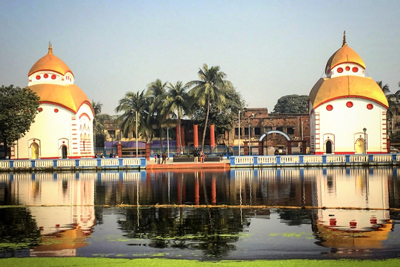
Located in Khidirpur, the twin heritage Bhukailash Shiva temples standing by the side of a huge pond, called Shivaganga, were built on the land of the Bhukailash Rajbari estate by Raja Joynarayan Ghosal, when he had to shift his base from the Fort William area by the order of the British rulers. Born in 1752, Joynarayan mastered several languages, including English and earned the Raja title from the Mughal ruler.
Following the examples of his ancestors, he made enough money by trading mainly in salt, gold and other metals, purchased 108 bighas (1337.80 sq m) of low land in Kalibagan area and constructed the Bhukailash Rajbari Complex, along with several temples, after improving the character of the land. In association with Raja Rammohan Roy, he also played an active role in the social reforms of Bengal.

The temple complex, separated from the Rajbari complex by a road, contains the two tall Shiva temples, constructed in the traditional Bengali Atchala style, distinguished by the roofs which are made up of eight parts.
The temples, facing each other across the open space, are equipped with triple-arched entrances and have two huge Shivalingas, the aniconic representation of Lord Shiva, both said to be 11 feet tall. The west-facing temple, located on the east of the pond, was dedicated to Raktakamaleshwar, named after Joynarayan’s father, while the east-facing temple on the west of Shivaganga was named Krishnachandreshwar, after the name of Joynarayan’s mother. Although it seems that the Raktakamaleshwar Shivalinga is slightly taller than the other, a plaque indicates that both the Shivalingas are of same height and are the tallest in India. The Raktakamaleshwar temple also has beautiful stucco works, which the other does not have and its foundation plaque indicates that the temple was built in 1702 Sakabda, which was 1780 AD. In the centre of the temple compound, there is a statue of Nandi, the sacred bull, the vehicle or vahana of Lord Shiva, made of black stone. Apart from that, there is also a memorial of Joynarayan Ghosal, on the other side of the Shivaganga pond.

Although declared a heritage site by the Calcutta Municipal Corporation in 1996, the temples remained unattended for a long time and the structures became dilapidated due to lack of maintenance.
Finally, the restoration project was taken up by the government body in 2013, which included the restoration and beautification of the pond and the temple courtyard, apart from the repairing, restoration and renovation of the crumbling old temples. After completion of the project, the renovated temple complex was opened to the public on 23 September 2013.
